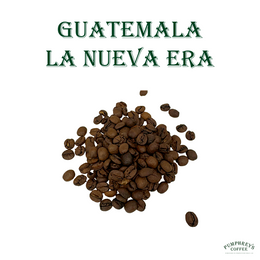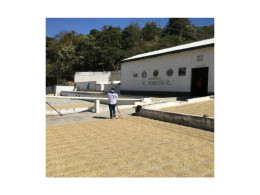Smooth Guatemala Huehuetenango Coffee
Guatemala Huehuetenango coffee beans are single origin, coming from the region of the same name.
Pronounced ‘way way ten an go’ this coffee is one of our most popular medium roasts. It can be perfectly created using most home brewing methods making it highly accessible for everyone, no matter how you enjoy your daily brew.
Taste
The flavour profiles of Guatemala Huehuetenango coffee are expertly balanced to guarantee a truly unique and satisfying experience. The maple notes provide a subtle sweetness that is complemented by the zesty, citrusy notes of orange.
Origin
Currents of hot air sweep up from the Plains of Tehuantepec, in Oaxaca, Mexico, and combine with the cool air descending from the Cuchumatanes Mountains. This creates a microclimate that’s protected from frost and enables coffee to be cultivated at up to 2,000 metres.
Huehuetenango’s extreme remoteness requires that nearly all producers process their own coffee. Fortunately, the region has abundant rivers and streams, making it relatively easy for producers to set up mills. What’s even more fortunate is the geographic conditions, which help to produce the exceptional, fresh Guatemala Huehuetenango green coffee beans with their distinct acidity and fruity flavours.
Ingredients
This coffee is a SHB EP, which specifies that the coffee was grown at an altitude above 1,350 meters. (This term is also synonymous with SHG/Strictly High Grown, a class that’s higher than HB.) EP (European Preparation) means that the green coffee was sorted by hand to remove any defective beans and foreign material.
Heritage
Coffee growing has helped fuel Guatemala’s economy for over a hundred years. Today, an estimated 125,000 coffee producers drive Guatemala’s coffee industry and coffee remains one of Guatemala’s principal export products, accounting for 40% of all agricultural export revenue.
It is most likely that Jesuit missionaries introduced coffee to Guatemala, and there are accounts of coffee being grown in the country as early as mid-18th century. Nonetheless, as in neighbouring El Salvador, coffee only became an important export crop for the country at the advent of synthetic dyes and industrial use in textiles – in the mid-19th century.
Throughout the latter half of the 1800s, various government programs sought to promote coffee as a means to stimulate the economy, including a massive land program started by President Justo Rufino Barrias in 1871, which resulted in the creation of large coffee estates, many of which still produce some of the best Guatemalan coffee available today.
Some questions answered about Guatemalan coffee....
How does Guatemalan Huehuetenango coffee taste?
Guatemalan Huehuetenango coffee is known for its unique and complex flavour profile, with notes of maple, orange, milk chocolate, and fruit that are expertly balanced to create a truly satisfying and delicious taste. The coffee grown in Guatemala is grown in various regions and the specific region where the coffee is grown can affect its flavour profile such as Huehuetenango which is known for its distinct flavour notes.
Is Guatemalan coffee strong?
The strength of Guatemalan coffee can vary depending on the roast level and brewing method used. A light roast will result in a lighter body and acidity, while a dark roast will result in a stronger, bolder flavour. Additionally, the brewing method used can also affect the strength of the coffee. For example, an espresso shot will be stronger than a pour-over.
Is Guatemalan coffee sweet?
Guatemalan coffee can have a sweet taste, with a balanced acidity and syrupy body. The sweetness in the coffee is often brought out by the maple and chocolate notes, and the juicy acidity adds a bright and lively dimension to the overall flavour profile. This balance of sweet and complex flavours makes it a versatile choice that can be enjoyed at any time of the day.
23 Reviews Hide Reviews Show Reviews
-
Guatemalan coffee
This is my favourite coffee by a mile
-
Guatemala Huehuetenango
The only coffee that pulls a perfect shot every time on my Sage Barista Express. It is delicious and I would thoroughly recommend it.
-
Guatemala Huehuetenango Coffee Beans
Full bodied, rich smooth taste.
-
Amazing roasters.
Excellent coffee. Taste was amazing. My lattes are always delicious
-
The 'Go To'
Love this bean - have the 6 month sub to provide some diversity and unexpected surprise but this is always close by as my 'go to'. Lovely.
-
This may sound pedantic, but my only complaint is the delivery by Royal Mail. Despite actually being in the house at the time of delivery, they opted to leave a card saying I wasn’t in and had to collect the next day from the collection office. Nex
As above

 Pound Sterling
Pound Sterling







